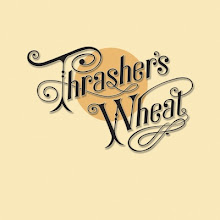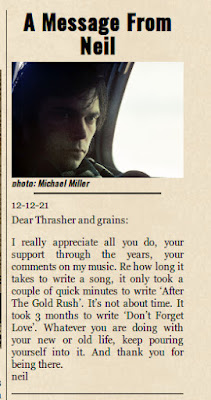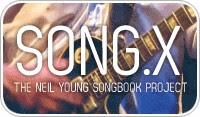| |
| Time Fades Away (50th Anniversary Edition) LP Buy Time Fades Away (50th Anniversary Edition) LP. Browse the vast selection of products available. |
| | |
In honor of the historic 50th anniversary of the legendary Neil Young album "TIME FADES AWAY", here is a deep dive into the album's title song "TIME FADES AWAY" by George K.
Nothing is too arcane to discuss for the hard-core Neil Young fan, it seems - especially for this group of fine people.
I
was thinking about the song, TIME FADES AWAY, and wondering just
exactly why Neil chose to use the numbers 14 and 13 “junkies too weak to
work” in the lyrics to this great song from the live album by the same
name.
We all know that it took decades for
this great album to finally be released on CD, and now it’s also
available as a remastered vinyl record album as well as a high quality
digital audiophile download at 192 kHz / 24 bit from Neil Young Archives
and the Greedy Hand Store online:
Time Fades Away (50th Anniversary Edition) LP
As
a songwriter and a lyricist, Neil is a master craftsman of putting
poetry to the service of the muse of music. I often wonder if it’s the
words or the music that comes first for him. Either way, his genius is
undeniable.
So, it makes one wonder exactly
why he chose the numbers fourteen and thirteen to include in his song
about time fading away and all that it implies in this life.
Was
it based on a true and factual event or scene that he saw? Probably not
- but who knows? How would he know that they were all heroin addicts?
Most
likely, he took poetic license and increased the number of down-and-out
junkies on the street in order to add emphasis to the problem, by
exaggerating it.
Also, as a musician and an
experienced recording artist, he knows that certain syllables create
sss-ey sibilant sounds in studio condenser microphones and that certain
other syllables like P’s and B’s create puffy and bassy sounds in live
dynamic microphones with proximity-effects.
So,
most likely, he chose a number with two syllables - that fit with the
rhythmic structure of the lyric - that was a word that started with a
sound that was neither sibilant nor puffy. Fourteen and thirteen both
hit the mark!
He could not use a one syllable
number, or a number larger than two syllables. Those would not work -
like the number nine or the number seventeen (which begins with an S and
has 3 syllables).
If you’re a singer, certain
words and sounds are easier to sing - and remember on stage - than
others. Fourteen and thirteen must have worked well for Neil in this
regard. They just sound good!
There’s also the
important matter of the imagery that’s conveyed. Let’s face it, the
first time you ever heard this song on the radio, that powerful and
unique image of “fourteen junkies too weak to work” left a very strong
impression in your mind! Songwriters are masters of matching lasting
lyrical imagery with catchy melodic hooks and rhythmic repeating riffs!
Neil does this all the time!
Anyway, these are just some of the thoughts that I was having about this great song that I wanted to share with you all.
Thanks for listening!
- George Nicholas Koumantzelis 👍🌵🌅🌲😇
Thanks for the deep dive here George! Most appreciate the detailed analysis of why we arrived at “fourteen junkies too weak to work”.
Afterall, we all know definitely that numbers add up to nothin'. :)
Seriously, we actually forgot about the whole arithmetic equation here. The songs starts with 14 junkies but ends with 13?! We lost Danny ... he was too weak to work.
Much more on the Neil Young album TIME FADES AWAY and fan's multi- decade struggle to have album re-released with petitions to record companies, beseeching the artist and his management. All of which culminated in a performance art attempt by fans at the end of a Neil Young concert in Philadelphia.
As one petitioner wrote all the way back in 2005 when we started the Release "Time Fades Away" Petition, not releasing TFA was "... like stashing Mona Lisa in the basement."

"It's like stashing Mona Lisa in the basement."
Petition Signature Signer #6628 by Gareth D.
A lot has happened since Thrasher's Wheat began the campaign to release Neil Young's 1973 album Time Fades Away way back in 2005.
More on the history and background of Release "Time Fades Away" Fan Petition.
 Release "Time Fades Away" Petition
Release "Time Fades Away" Petition
Labels: album, analysis, neil young, song, time fades away

































 Human Highway
Human Highway

















 Concert Review of the Moment
Concert Review of the Moment





 This Land is My Land
This Land is My Land

 FREEDOM In A New Year
FREEDOM In A New Year









 *Thanks Neil!*
*Thanks Neil!*




![[EFC Blue Ribbon - Free Speech Online]](http://www.thrasherswheat.org/gifs/free-speech.gif)











 The Unbearable Lightness of Being Neil Young
The Unbearable Lightness of Being Neil Young Pardon My Heart
Pardon My Heart



 "We're The Ones
"We're The Ones  Thanks for Supporting Thrasher's Wheat!
Thanks for Supporting Thrasher's Wheat!




 This blog
This blog 
 (... he didn't kill himself either...)
#AaronDidntKillHimself
(... he didn't kill himself either...)
#AaronDidntKillHimself








































































 Neil Young's Moon Songs
Neil Young's Moon Songs




 Civic Duty Is Not Terrorism
Civic Duty Is Not Terrorism Orwell (and Grandpa) Was Right
Orwell (and Grandpa) Was Right


 What's So Funny About
What's So Funny About 



13 Comments:
This comment has been removed by the author.
Numerology not my #1 area (🙃) Thirteen is a traditional unlucky number, as in Fri the 13th. Akin to 666. Three and multiples thereof actually come up a lot in these conversations. 13 (which obviously has a 3 in it) is an odd number, one off from 12, a multiple of 3. Who knows? Maybe NY wanted the song to end on a bad number. Don’t even know if words came before or after music.
I always took the decreased quantity of junkies in the last verse to mean one of them died, so it has to be the starting number minus one.
I agree with the syllables, the ending on a bad number, and one of them died. This is a cursed song. Archives documents show two “Back By Eight” manuscripts: one with all the lyrics, and an ostensibly earlier rehearsal sketch with chords and lyrics to help Danny Whitten learn the new song. This version does not have the “junkies” lyrics. Chillingly, it appears that those lines were written immediately after the guitarist’s death.
Tomatron— Woah, that is spooky. I take it “Home by Eight” was an early title for the song TFA, just as Monday Morning became Last Dance? I missed that tidbit somewhere along the line.
real darkness in our lives clouds the mind and beckons dread. it is impossible to live or work with dread as it is accelerated fear. creation requires some place of safety. Post dread is enervating. What are the objects of dread? That which are inconsistent with creation, that which are inconsistent with art, that which are inconsistent with the freedom that we make for ourselves (together).
Abner, you’ve been enthusing on I’m the Ocean for ages. Now hearing it on Before + After, I’m wondering how the song largely escaped my notice for years. The rhythm and repetition of the music underscores the onslaught of sensory impressions and hollow stimuli described in the lyrics. This simple structure is relentlessly propulsive, yet it’s headed nowhere particular. It swims in circles, treading water. Sound and fury. Enervation and hyper-stimulation. In the context of B+A, it’s perfect set up to make the gentle music that follows a real sublime relief.
You were right, Mirror Ball is overdue for revisiting.
It seems to me (anyway) that you are right on MR. It is relentlessly propulsive, which is what first caught my attention. The music seems like violent labor, closing in on exhaustion. In the end it is dread. Trembling from the knife with no one to help or comfort. Distractions which wear on the best of our humanity, distractions piled on distractions. Now we have binge watching (whatever happened to "too much TV"?) The episodic shows are not great art, as some think, instead they hook onto gimmicks (the "cliffhanger") and assure audience captivity. A lack of resolution is a clear sign of conformity. This, to me, beckons dread. I want to live my life in conversation. Even as I am constantly critical, I love discussion with people. MR I wish you a happy holiday and thanks for all of your contributions.
Spontaneity is a sign of life.
Honestly, I would place Mirror Ball and Tonights the Night as two sides of the same album. Tonights the Night is cathartic, grief-soaked, tragic sadness and we can see the way out. Mirror Ball is the dread that comes before any catharsis and may not lead there. Everything depends on how we can manage our self-defeating mistakes. In short, Mirror Ball is more cultural, Tonights the Night is deeply personal with cultural implications. The artist is defining the territory of art. Nothing works well in a place of pure ease, relaxation, or "self-hypnosis."
This comment has been removed by the author.
This comment has been removed by the author.
Abner, Oddly a lot of your thoughts about Mirror Ball mirror mine on Sleeps with Angels. Except SWA, to me, seems like the catharsis itself. Strangely typical of NY to do the catharsis before the build-up/rising action. TtN is a bit different because it ends where it starts, literally with a reprise of the first song. SWA has bookend songs, but with a more evident emotional arc from despair to hope.
As bleak as so much of SWA is, I’ve always felt it’s essentially a hopeful work. Hope amid sadness and pain. There is a sense of resolution, albeit of a giddy, almost manic sort, by the end of Dream that Can Last? Was it a hallucination or figment of the singer’s imagination? Is the heavenly vision pure delirium or was there an actual moment of transcendence?
Re: I’m the Ocean, there are other NY songs that have a similar propulsive edge. Simple chord progressions repeated (almost) ad nauseam, in a manner of speaking. Ordinary People and She's a Healer are far flung examples. The latter is an especially fascinating case, given the sensual overtones of She’s a Healer. The effect is almost incantatory, like chanting. Rhythm is the physical (bodily) core of ritual. The real mystery may be the power music has in melting down the body/soul duality principally through rhythm. This is music as the third term, the spirit.
(Am I speaking David Briggsian yet?)
In these inverted truth times the #13 is actually a very lucky number. It breaks down to 4 like the medicine wheel, the four directions and is actually very powerful.
In the last couple of weeks I had kind of a major event in my life happen with numbers. For some reason my Youtube "recently added" heading had a year-old video that only had 11 hits but it really caught my eye. I contacted the person being interviewed in that rarely seen video and he agreed to meet me for research on Pilot Mountain. He is one of only 300 pure blooded Cherokee left in the world and has been doing sweat lodges for over fifty years hearing the elder Cherokee stories by the wisdom keepers. His name is Yona FrenchHawk and he is a very humble man. He was a friend of John Trudell and that says a lot. So I checked the views when I got home from our first two-day visit together and there were 22 views. After going to his winter solstice ceremony in Asheville a week later the views were 44. I watched it again over coffee this morning so it is now at 45.
11, 22, 33 and 44 are all master numbers that are symbols you'll see a lot when you become aware of them. An example: the day JFK was murdered most foul.
Here is that video that started the whole chain reaction for me this month...I wonder if Neil knows Yona? I've recommended he become a columnist to the NYA team.
https://www.youtube.com/watch?v=63o1YvtFZ-U&t=1123s
Hoi,(hear a sound) here's a message from Holland (the Netherlands) in Europe."Time fades away" my all-time favourite album,same as "On the Beach".They marked periods in my life that made a deep impression on me and shaped me the way I am nowadays."Sometimes you win,sometimes you lose",wise words sang by Neil."Take my advice,don't listen to me",but I did.And it helped me through dark times and showed me that "Good times are coming" and so they did.Much obliged to you,Neil,take care and have a good terrific year with friends and family.Cees Mostert.
Post a Comment
<< Home